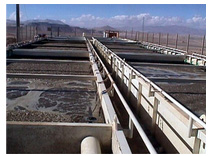Technologies
Purification of Water
Varied technologies are used in the purification of water, its main function is to eliminate, reduce or remove the impurities incorporated in the fluid. These impurities can be organic or inorganic and be dissolved or suspended in water. Depending on the situation, defines the technology used in the treatment of water, in order to achieve the desired quality.
Aguasin leads the market thanks to its professional capital and speed to adopt advanced technologies. As a result of the above, we can say that we provide solutions and deliver the highest level.
In Aguasin we count with professionals dedicated to delivering the best solutions. Contact Us and we will answer your request.
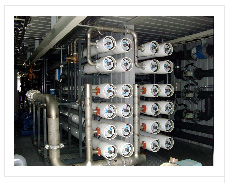
Absorption
Absorption is a surface process in which, through electrical charges hold by the particles are attracted to other particles taking part of a filter medium or absorbing medium. Absorption occurs mainly by electrical forces, or the approach of molecular particles of a surface tension compatible with the surface tension of the medium in which it faces.
Aguasin uses filter media capable of retaining or removing elements or particles at the molecular level through the use of filter media superficially actives such as carbons, zeolites, glauconite, etc.. The use of absorption allows to conditionate water to achieve a physical and chemical quality compatible with the intended use to be delivered.
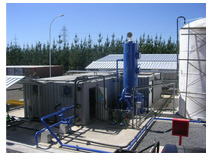
Membrane Contactors
The presence of gases dissolved in the water generally has an adverse effect on the processes followed in its use. In order to remove these gases, Aguasin used a semi-permeable membrane that allows diffusion from water into an air stream, separated by this type of membrane. This process occurs by applying a vacuum on one side of the membrane, allowing the diffusion of dissolved gas from the water into the gas phase (vacuum).
Aguasin is a leader in design, incorporating these membrane contactors in modular water plants.One advantage is that it uses significantly less space than the absorption columns and automation is easier to control.
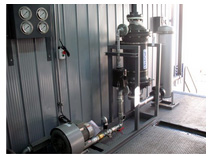
Degassing Column
The gases, as solids, may be present in water in dissolved form, or can be generated in the water coming from some modification of the remaining balances of dissolved species. These gases are often detrimental to product quality or the operation of an equipment or system. Therefore, dissolved gases or produced in the flow of water must be removed from them. For this, water is circulated in counter-current with air flow through a tower or column that is filled with a material that facilitates contact between water droplets (or films) and air. Columns with trays that produce a cascade effect are also designed, to ensure water / air contact. For this phenomenon, dissolved gas is absorbed in the flow of water in the airflow.
Aguasin has designed degassing towers, both with fillers such as trays, to remove gases from the water, process water conditioning (removal of CO2 permeate) and to remove O2 in the boiler feed water. In the latter case used trays has been used to avoid damage to the temperature in synthetic fillings.
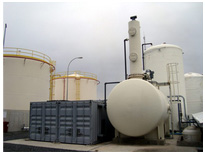
Electrodeionization
The Electrodeionization is a recent technology that allows industrial application through a combination of ion exchange and membranes technology, achieving high purity product water. For that, it requires a water supply with well-defined characteristics of a rectified power source to generate positive and negative fields to where the cations and anions migrate from water supply.
Aguasin has pioneered this technology at industrial level in Chile, obtaining high purity water for high pressure boilers and open cycle power plants.
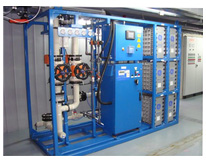
Flotation
Flotation is a natural process in the way solid bodies behave towards the water. That is, as a separation technology, flotation makes possible to recover, eliminate and separate etc., water pollutants, through its natural buoyancy or induced by chemical or a stream of air (bubbles) up.
Flotation in water treatment has been developed to the point that, by external pressure, it is possible to saturate the air flow, so that when pressure is released into a cell, microbubbles are generated by release of dissolved air. This phenomenon allows "drag" and dissolved the solid parts (of a certain molecular size) to the cell surface, where they are removed by mechanical action.
Aguasin through external manufacturers of flotation cells, incorporates this technology into the separation of water contaminants, particularly in industrial liquid waste (LIW) or organic downloads
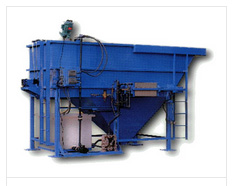
Ion Exchange
Ion exchange is a process in which there is a modification of the components that the water has, and, in turn, there is an incorporation of other elements that are known and measured, so that the water acquires a property suitable for the intended use. That is, the water is passed through a filter media, porous, which has a concentration of elements arranged to be exchanged for items that are required to remove the water. As this is a chemical reaction where the cut links between atoms and bonds between atoms occur, the result is that it generates an ion exchange. Since the chemical reaction is governed by the degree of concentration of the components to exchange and chemical equivalence, it is possible to condition the water for a particular purpose.
Aguasin uses this technology through the design of equipment with ion-exchange resins can remove positive (or cations) and negative (or anions) particles, as the exchange component.
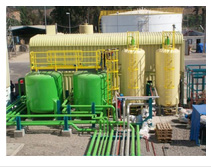
Divisions by Filter Media
The filtration consists on the removal of suspended and colloidal particles present in a suspension that drains through a porous means. As the forces that maintain the suspension removed particles attached to the surfaces of the grains of the filtrating means are active for relatively small distances (some angstroms), the filtration is usually considered as the result of two different but complementary mechanisms: transportation and attachment. Initially, the particles to be removed are transported from the suspension to the surface of the grains of the filtrating means. They remain attached to the grain, only if the resist the action of the forces of shaving due to the hydrodynamic conditions of the runoff.
The transportation of particles is physic and hydraulic phenomena, mainly affected by the parameters that govern the mass transference. The attachment between particles and grains is basically a phenomenon of superficial action, which is by physic and chemical parameters.
Aguasin, throughout time has developed filtration equipment achieving that the theory expresses the results of the experimental investigation, so as to pro foresee, in the design, how the filtration unit will operate in praxis.
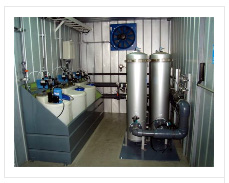
Technologies of Ultrafiltration/Microfiltration Membranes
Some decades ago semi-permeable membranes were developed with the ability to "filter" a certain size of molecules, based on the natural phenomenon of diffusion of fluids, specifically through a natural membrane. From there, technologies have been developed by an external pressure (or other synthetic membranes)which is able to remove pollutants from water, to purify it for various uses.
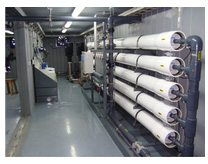
Biological Treatments
The biological treatment of water has a wide application in water drains or discards generated by the human population or by any organic manufacturing process. In the case of sewers of human waste, biological treatment is applied to reduce biochemical oxygen demand, which occurs by the proliferation, in an aerated reactor,of a bacterial flora that degrade organic matter. As this process occurs through the injection of air, known as aerobic process.
In the event that the organic load of effluent is higher than the usual holding human waste, an anaerobic stage is considered, which produces a degradation of organic matter and a generation of gases. Such biological treatment can generate both products for power generation by combustion of residual gases or liquids such as fuel. Thus, the sludge from the digesters are placed in dumps and used for the benefit of soil.
Aguasin has developed standardized plants for treating domestic sewage, as well as the ability to design and build industrial liquid waste plants to the use of the bacterial flora as a catalyst for purification processes.
